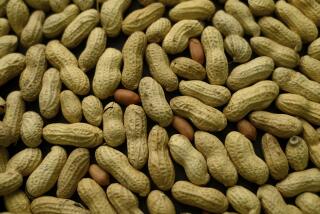It’s Tricky to Find Treats for Kids With Food Allergies
- Share via
Just the thought of Halloween scares me.
It’s not the frighteningly costumed kids that might give my 5-year-old son nightmares or the off chance that he will eat a piece of poisoned candy.
It’s the very real chance that he will inadvertently eat some candy containing peanuts or eggs that could make him very sick, or even kill him.
So as most parents are inspecting their kids’ loot for signs of tampering, I will be carefully reading ingredient labels. Into the “unsafe candy” pile goes anything that includes peanuts or eggs or bears the words “May contain traces of peanuts,” as many manufacturers now print on their packages. And of course, any treat without an ingredient label is off-limits, because we can never assume a food is safe without seeing it in writing.
Although food allergies have been in the news a lot lately, our family has been dealing with this issue for the last four years, ever since my son, Jesse, had two life-threatening allergy attacks.
When he was 11 months old, I fed him scrambled egg yolks for the first time. He went into shock in a matter of minutes. The paramedics came and rushed him to the hospital, where a shot of epinephrine revived him.
Four months later, a baby-sitter unknowingly gave Jesse a bite of her peanut-butter sandwich. He went into shock again, but this time I was prepared. I rushed home and gave him an epinephrine shot called EpiPen that, once again, brought him back to this world.
With Halloween drawing near, I start to get nervous, thinking of all the candy containing peanuts and eggs that will be dropped into Jesse’s little orange pumpkin. I guess we could play it safe and forbid him to go trick-or-treating, but my husband and I aren’t willing to deny him this annual ritual. Thirty years after I last shouted “trick or treat!,” I can still remember every costume I donned.
So, we do everything in our power to keep him safe, which involves a bit of trickery on my part.
A few days before Halloween, I go to the store and start reading candy labels, searching for safe candy to buy. Next, I sneak over to a few neighbors’ houses and leave the candy in a brown paper bag with Jesse’s name on it. I ask them to casually give him the candy (sans bag) when we arrive to ensure that he gets a few things he can eat.
While we’re making our rounds on Halloween, we follow two rules: Always carry the EpiPen, and don’t eat anything until we get home and can carefully check the labels. Even though he’s not allowed to indulge while we’re out, I fear he could have a reaction, albeit small, just from being that close to peanut-containing candy. (He is so sensitive to peanuts that once during preschool, he got hives when several classmates were simultaneously eating peanut-butter and jelly sandwiches in the classroom.)
At home, we carefully examine each piece of candy, tossing aside the obvious ones like Snickers, which contains peanuts, and the not so obvious, like taffy, which contains eggs. In the same pile, we put candy that doesn’t have an ingredient label. Sadly, his “loot” has usually diminished by about 90%.
But Jesse’s a good sport about it, thanks to the “Great Pumpkin,” who turns his candy into a cool toy. He agrees to surrender the unsafe candy to the Great Pumpkin, who whisks it away in the middle of the night and replaces it with a wrapped present that he opens the next morning.
To me, he’s the big winner. Not only does he get to go trick-or-treating, but he gets enough candy to last a week or so, plus a toy that will hopefully capture his interest for longer than that. (This year, he’s asking the Great Pumpkin for a robotic dog.) Someday, he’ll figure out the truth about the Great Pumpkin, and we’ll have to make some adjustments. But as long as he desires, Jesse will go trick-or-treating. It’s a rite of passage that every kid should experience.
More to Read
Eat your way across L.A.
Get our weekly Tasting Notes newsletter for reviews, news and more.
You may occasionally receive promotional content from the Los Angeles Times.






